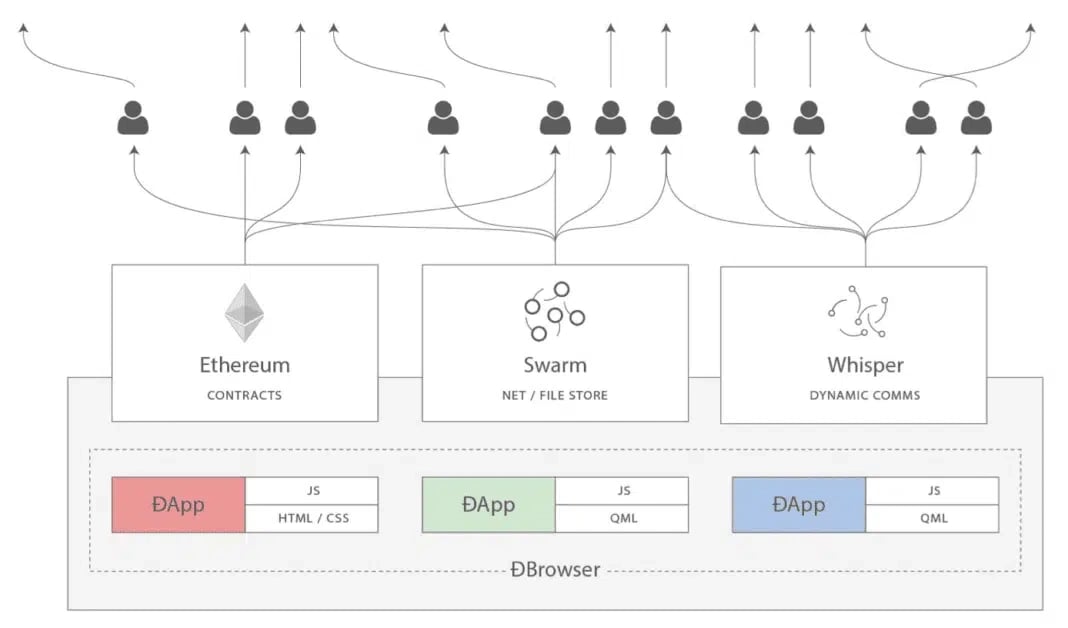위키 구독하기
Share wiki
Bookmark
Whisper
Whisper
**위스퍼(Whisper)**는 이더리움 네트워크에서 안전한 P2P 메시징을 위한 프로토콜입니다. 위스퍼는 이더리움 네트워크의 분산 애플리케이션(dApps) 및 사용자에게 안전하고 개인적인 통신 채널을 제공하도록 설계되었습니다.[1][5]
개요
위스퍼는 블록체인 기술을 지원하는 분산 원장 시스템에서 분산 앱(Dapps)을 구축하기 위한 프로토콜이며, DApps 간의 메시징을 허용합니다. 이더리움 블록체인을 통해 암호화된 메시지를 보내고 해시 키를 사용하여 메시지를 수신 및 복호화하는 데 사용할 수 있는 간단한 API를 제공합니다.
위스퍼는 프로토콜로 구축되고 있으며, 이는 상위 수준의 구현, 즉 위스퍼를 기반으로 구축된 다양한 변형, 프로토콜의 다양한 기능 사용 및 다양한 설정을 사용하는 DApps에 대한 기반을 마련한다는 것을 의미합니다. 위스퍼 프로토콜 구현은 이더리움이 노드 간 통신에 내부적으로 사용하는 RLPx 전송 프로토콜을 기반으로 구축됩니다. [5]
위스퍼는 Geth 및 Parity 클라이언트를 지원합니다. DApps 게시-구독 조정 신호 및 안전하고 추적 불가능한 분산 통신 구축에 사용할 수 있습니다. [2][6]
위스퍼는 관찰자로부터 메시지 내용과 송신자 및 수신자의 신원을 숨깁니다. 위스퍼의 메시지는 TTL(Time-to-Live) 타이머를 가지므로 특정 기간 후에 만료됩니다. 이 시스템은 이중 데이터 암호화 계층에 의존합니다. [4]
이더리움 위스퍼 통신 프로토콜의 전체 개념은 다음 세 가지 목표를 중심으로 합니다. [3]
- 사용자에게 유연한 시스템 제공
- 이더리움에서 안전한 통신 채널 구축
- 무엇보다도 사용자의 온라인 익명성 보장
초기에는 위스퍼가 분산 애플리케이션(DApps) 간의 개인적이고 안전한 메시징을 가능하게 하려는 이더리움의 광범위한 목표의 일환으로 개발되었습니다. 그러나 시간이 지남에 따라 채택 속도가 느려졌으며 대부분 광범위한 구현을 달성하기보다는 개념 증명 단계에 머물러 있습니다. 위스퍼의 모든 기능은 여전히 사용 가능하지만 많은 개발자는 이제 대체 통신 프로토콜을 선호합니다.
웹 3.0을 위한 이더리움의 3대 기둥 중 하나로서의 위스퍼
최근 Gavin Wood는 'Dapps: Web 3.0의 모습'을 발표했습니다. 여기서 우리는 분산되고 암호화된 정보 게시 시스템, 익명의 저수준 메시징 시스템 및 합의 엔진을 통해 가능해진 “제로 트러스트 상호 작용 시스템”으로서의 인터넷을 소개받습니다. [7]
이더리움 생태계에서 웹 3.0은 세 가지 기둥의 형태로 구현되는데, 그중 하나가 안전하고 분산된 메시징 프로토콜로서 DApps의 출현과 웹 3.0의 확장을 가져오도록 설계된 이더리움 위스퍼 프로토콜입니다.
- 첫 번째 기둥은 신뢰할 수 있는 불변 백엔드로서 이더리움 블록체인에서 실행되는 스마트 계약 기술입니다. 스마트 계약을 사용하면 웹 서버 대신 신뢰할 수 있는 P2P 프로토콜 위에 분산 애플리케이션의 코드가 실행됩니다.
- 두 번째 기둥인 분산 스토리지는 Swarm 형태로 찾을 수 있습니다. 이를 통해 웹 인터페이스 및 대용량 데이터와 같이 DApps의 오프체인 부분을 분산 방식으로 저장할 수 있으므로 중앙 집중식 파일 저장소 또는 데이터베이스가 필요하지 않습니다.
- 웹 3.0 비전의 세 번째 요소는 개인 정보 보호 중심의 안전한 메시징을 포함합니다. DApps가 블록체인 트랜잭션 컨텍스트 외부에서 메시지 버스를 통해 통신해야 하는 여러 상황이 있습니다. 메시지 버스를 통해 애플리케이션이나 사용자가 지점 간 또는 브로드캐스트 방식으로 메시지를 교환할 수 있습니다. 전통적으로 이는 중앙 집중식 메시지 서버를 통해 달성되었습니다. DApps가 통신을 오프체인으로 유지해야 하는 이유는 다음과 같습니다.
- 개인 정보 보호
- 메시지 유효성의 임시 제한(TTL 속성)
- 온체인 트랜잭션 비용
이더리움에서 위스퍼 프로토콜은 안전한 오프체인 메시지 버스 역할을 하도록 설계되었습니다. [5]

기술
위스퍼 프로토콜은 공개 키 암호화 및 분산 해시 테이블(DHT)을 결합하여 메시지가 안전하고 개인적인지 확인합니다. 네트워크의 각 사용자에게는 고유한 공개 키가 할당되며, 이 키는 해당 사용자에게 보내는 메시지를 암호화하는 데 사용됩니다. DHT는 이러한 암호화된 메시지를 안전하게 배포하고 저장하여 중앙 집중식 서버 없이 P2P 통신을 가능하게 합니다.
위스퍼의 주요 기능 중 하나는 사용자가 특정 유형의 메시지 또는 대화를 구독할 수 있도록 하는 “토픽” 또는 “채널”을 지원하는 것입니다. 이를 통해 dApps 및 사용자가 이더리움 네트워크에서 특정 커뮤니티 또는 그룹을 쉽게 만들고 참여할 수 있습니다.
위스퍼는 또한 경량이고 효율적으로 설계되어 모바일 장치 및 기타 리소스 제약 플랫폼에서 사용하기에 적합합니다. 이는 이동 중에도 사용자에게 안전하고 개인적인 메시징 기능을 제공해야 하는 dApps 및 기타 프로젝트에 매력적인 솔루션입니다. [1]
이 시스템은 이중 데이터 암호화 계층에 의존합니다. [3]
- 대칭 암호화는 단일 암호화 및 복호화 키를 사용하여 일대다 통신을 전송할 수 있도록 합니다. 메시지 수신자는 자신에게 보낸 메시지를 복호화할 수 있습니다.
- 비대칭 암호화는 암호화에 공개 키를, 복호화에 개인 키를 사용합니다. 다른 사람과 통신할 때 시스템은 이러한 유형의 암호화를 사용합니다.
위스퍼는 devp2p의 ssh 프로토콜 문자열을 사용합니다. 암호화된 메시지를 보낼 때 메시지 내용은 기본적으로 비대칭 또는 대칭으로 암호화될 수 있습니다.
공개 키 암호화라고도 알려진 비대칭 암호화는 데이터를 암호화 및 복호화하는 데 공개 키와 개인 키를 사용합니다. 하나의 키는 공개 키이며 모든 사람과 공유됩니다. 다른 하나는 개인 키이며 소유자만 개인 키 정보를 볼 수 있거나 액세스할 수 있습니다. 위스퍼 메시지를 암호화할 때 메시지를 암호화하는 데 SECP-256k1 공개 키를 사용하는 표준 타원 곡선 통합 암호화 체계를 사용하고 다른 키는 복호화에 사용됩니다. 반면에 비밀 키라고도 알려진 대칭 암호화는 암호화 및 복호화 모두에 대해 난수 96비트 논스를 사용하는 AES GCM 알고리즘을 사용하여 해시 키를 사용합니다. 일반적으로 일대다 메시지를 용이하게 합니다. 송신자와 수신자는 메시지를 암호화 및 복호화하는 데 동일한 대칭 키를 사용합니다. [2]
잘못된 내용이 있나요?
